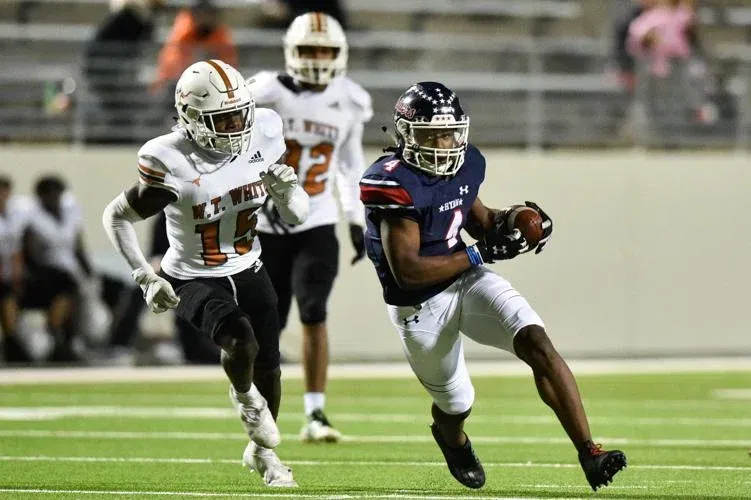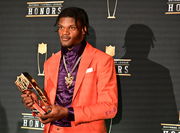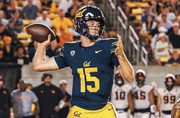

Last season in Fort Worth, a redshirt freshman named Jordyn Bailey snatched the spotlight with one play that had the whole Big 12 buzzing. Against Oklahoma State, Bailey took a reverse 59 yards to the house, putting the burners on and making the Cowboys look like they were jogging in quicksand. It wasn’t a fluke either—this running back had already flashed with a one‑handed touchdown grab against Baylor and ended the year with 9 catches for 52-ish yards, 74 rushing yards, and 11 kick returns at 21.3 yards a pop. That’s the résumé of a young man who can hurt you in a dozen different ways.
Watch What’s Trending Now!
Where is Jordyn Bailey from, and what is his nationality?
Bailey’s roots trace straight back to Texas. He grew up in Denton, sharpening his game at Ryan High School, the same program that’s pumped out D‑I talent like clockwork. Born and raised in the United States, Bailey holds American nationality. His exact date of birth hasn’t hit the public yet, but as of 2025, he’s in his sophomore year (20 as per NCSA Sports) rocking the Horned Frogs jersey.
ADVERTISEMENT
In high school, he was a four‑star recruit, ranked the No. 91 wide receiver nationally by ESPN and the No. 102 prospect overall in Texas. Bailey was no one‑trick pony—he hauled in 30 passes for 396 yards and six touchdowns, rushed for another 336 yards with two scores, and still had enough juice left to clock 11.36 in the 100 meters while long jumping 22 feet. Yeah, he’s built like that.
View this post on Instagram
ADVERTISEMENT
What is Jordyn Bailey’s ethnicity?
Culturally and ethnically, Jordyn Bailey identifies as African‑American. His parents and extended family reflect a deep Black heritage rooted in Texas and Louisiana. His mom, Casaundra Bailey, was a baller herself—a former runner and basketball player—who knew exactly how to toughen her kids up for the grind. She raised three kids solo, making discipline non‑negotiable. Jordyn’s older brother, Emani Bailey, tore it up as a TCU running back before moving on to the NFL radar, proving the family’s athletic DNA runs strong.
Top Stories
Ravens’ Lamar Jackson Demands Short-Term Contract Away From NFL on Thursday

‘RIP’: NASCAR World Crumbles in Tears as 39-YO Former JR Motorsports Driver Passes Away

NASCAR President Kicks Up ‘SRX’ Firestorm With Courtroom Claim Fans Refuse to Accept

Watch: Scottie Scheffler Left Stunned as the Ball Betrays Him

Yankees Offensive Free agency Ends Early as Cody Bellinger-Kyle Tucker Pursuit Ends Before Beginning: ESPN Insider

Who are Fernando Mendoza’s Parents? All about Elsa Mendoza and Fernando Mendoza

ADVERTISEMENT
Is Jordyn Bailey African-American? What is his religion?
Yes, Bailey is African‑American, and his faith has been stitched into his life story since day one. Raised in a Catholic household, Bailey was introduced early to prayer, discipline, and spiritual grounding. But college was where he had to make his faith his own. “Nobody was pushing me to pray, read my Bible, or go to church anymore. I had to take the initiative—and I did,” he told TCU Magazine. That step flipped a switch for him. “Now I walk into any room with confidence, and I see people beyond the surface. That’s God working through me.” For Bailey, religion isn’t a checkbox—it’s the anchor that lets him ball out under pressure.
Influence of upbringing on faith and character
If you want to know why Bailey plays with such grit, you have to look past the stadium lights and into his backyard training sessions. When the family moved to Aurora, Colorado, it was his grandfather—lovingly called “Papa”—who filled the father‑figure role. With Bailey’s dad absent, Papa turned their yard into a training ground, tossing passes, running drills, and molding both Jordyn and Emani into football junkies.
ADVERTISEMENT
Then there’s Casaundra’s legendary conditioning sessions. Jordyn remembers sprinting with masks on to build endurance, his mom refusing to let up. “Every time I would complain or say I was tired, her response was the same: ‘I don’t care. Keep running!’” That’s where the Bailey brothers learned toughness wasn’t optional—it was expected. Now, when Bailey lines up for TCU in big 2025. He’s carrying the weight of his roots—Texas grit, Louisiana faith, and family bloodlines that demand nothing short of all‑out effort.
ADVERTISEMENT
ADVERTISEMENT
ADVERTISEMENT

